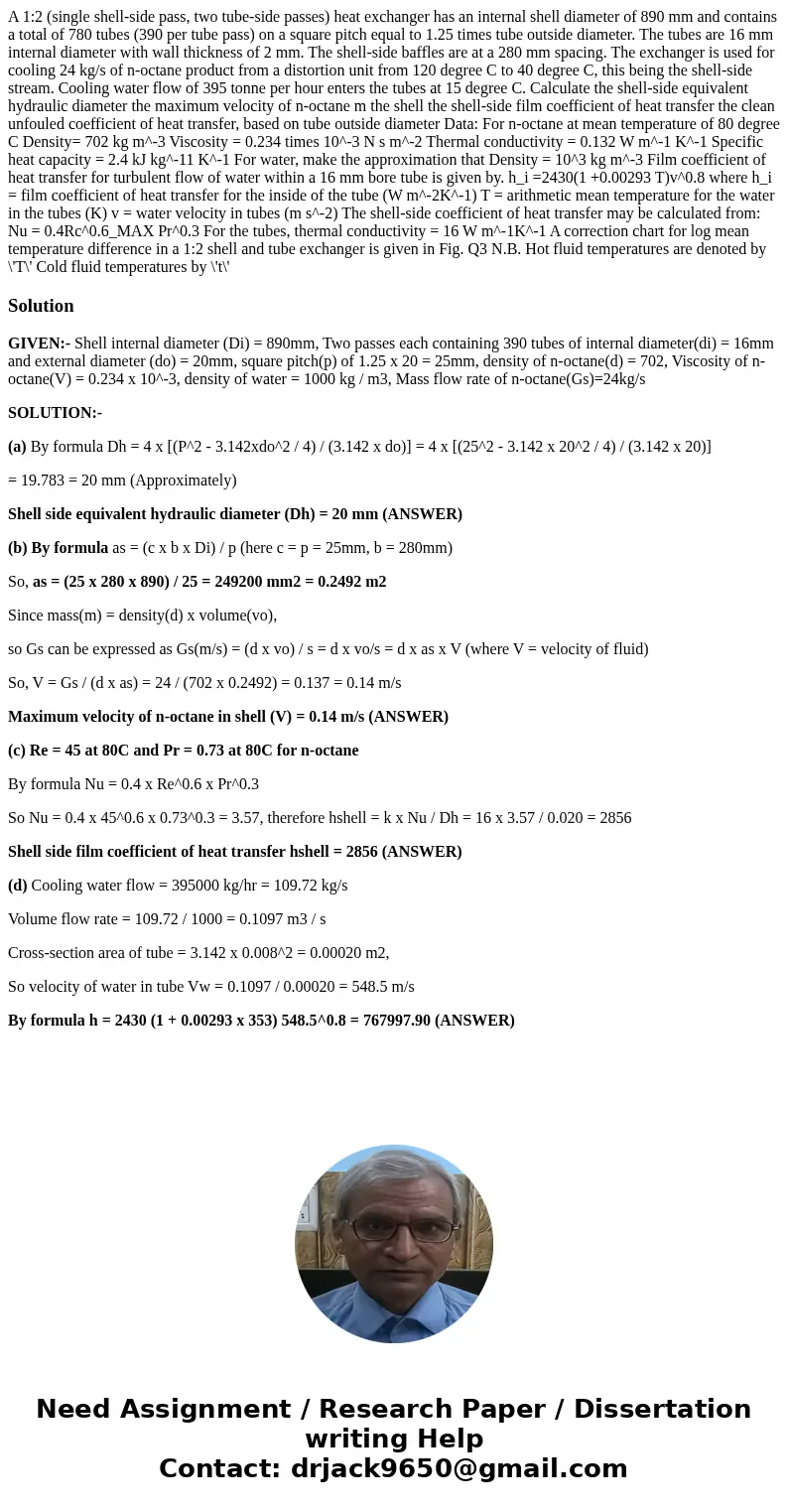A 1:2 (single shell-side pass, two tube-side passes) heat exchanger has an internal shell diameter of 890 mm and contains a total of 780 tubes (390 per tube pass) on a square pitch equal to 1.25 times tube outside diameter. The tubes are 16 mm internal diameter with wall thickness of 2 mm. The shell-side baffles are at a 280 mm spacing. The exchanger is used for cooling 24 kg/s of n-octane product from a distortion unit from 120 degree C to 40 degree C, this being the shell-side stream. Cooling water flow of 395 tonne per hour enters the tubes at 15 degree C. Calculate the shell-side equivalent hydraulic diameter the maximum velocity of n-octane m the shell the shell-side film coefficient of heat transfer the clean unfouled coefficient of heat transfer, based on tube outside diameter Data: For n-octane at mean temperature of 80 degree C Density= 702 kg m^-3 Viscosity = 0.234 times 10^-3 N s m^-2 Thermal conductivity = 0.132 W m^-1 K^-1 Specific heat capacity = 2.4 kJ kg^-11 K^-1 For water, make the approximation that Density = 10^3 kg m^-3 Film coefficient of heat transfer for turbulent flow of water within a 16 mm bore tube is given by. h_i =2430(1 +0.00293 T)v^0.8 where h_i = film coefficient of heat transfer for the inside of the tube (W m^-2K^-1) T = arithmetic mean temperature for the water in the tubes (K) v = water velocity in tubes (m s^-2) The shell-side coefficient of heat transfer may be calculated from: Nu = 0.4Rc^0.6_MAX Pr^0.3 For the tubes, thermal conductivity = 16 W m^-1K^-1 A correction chart for log mean temperature difference in a 1:2 shell and tube exchanger is given in Fig. Q3 N.B. Hot fluid temperatures are denoted by \'T\' Cold fluid temperatures by \'t\'
GIVEN:- Shell internal diameter (Di) = 890mm, Two passes each containing 390 tubes of internal diameter(di) = 16mm and external diameter (do) = 20mm, square pitch(p) of 1.25 x 20 = 25mm, density of n-octane(d) = 702, Viscosity of n-octane(V) = 0.234 x 10^-3, density of water = 1000 kg / m3, Mass flow rate of n-octane(Gs)=24kg/s
SOLUTION:-
(a) By formula Dh = 4 x [(P^2 - 3.142xdo^2 / 4) / (3.142 x do)] = 4 x [(25^2 - 3.142 x 20^2 / 4) / (3.142 x 20)]
= 19.783 = 20 mm (Approximately)
Shell side equivalent hydraulic diameter (Dh) = 20 mm (ANSWER)
(b) By formula as = (c x b x Di) / p (here c = p = 25mm, b = 280mm)
So, as = (25 x 280 x 890) / 25 = 249200 mm2 = 0.2492 m2
Since mass(m) = density(d) x volume(vo),
so Gs can be expressed as Gs(m/s) = (d x vo) / s = d x vo/s = d x as x V (where V = velocity of fluid)
So, V = Gs / (d x as) = 24 / (702 x 0.2492) = 0.137 = 0.14 m/s
Maximum velocity of n-octane in shell (V) = 0.14 m/s (ANSWER)
(c) Re = 45 at 80C and Pr = 0.73 at 80C for n-octane
By formula Nu = 0.4 x Re^0.6 x Pr^0.3
So Nu = 0.4 x 45^0.6 x 0.73^0.3 = 3.57, therefore hshell = k x Nu / Dh = 16 x 3.57 / 0.020 = 2856
Shell side film coefficient of heat transfer hshell = 2856 (ANSWER)
(d) Cooling water flow = 395000 kg/hr = 109.72 kg/s
Volume flow rate = 109.72 / 1000 = 0.1097 m3 / s
Cross-section area of tube = 3.142 x 0.008^2 = 0.00020 m2,
So velocity of water in tube Vw = 0.1097 / 0.00020 = 548.5 m/s
By formula h = 2430 (1 + 0.00293 x 353) 548.5^0.8 = 767997.90 (ANSWER)

 Homework Sourse
Homework Sourse